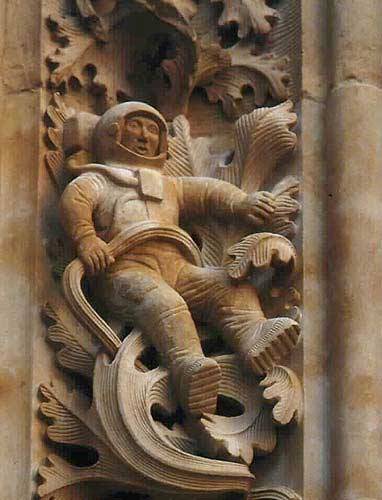I love this picture from the Porco Cane blog:-

During 1992 restoration work on the Cathedral of Salamanca, this astronaut ensnared by vines was added by Jeronimo Garcia, along with “a dragon eating ice cream, a lynx, a bull, and a crayfish“, all approved by the appropriate committee etc. Perhaps this will confuse archaeologists a millennium hence? Probably not.
Doubtless more than a few of our problems with the Voynich Manuscript arise from looking at it out of its original context: perhaps it too consists of ancient visual themes peppered with humorous contemporary additions, but we are too far removed in time to see the jokes, let alone get them?
I’m sure we have some similar figures on the Winnett Center here at Caltech. I’ll try to get a photo tomorrow.
“Perhaps this will confuse archaeologists a millennium hence?”
A similar situation obtains at, I believe, St. Ouen’s Pond in Jersey, Channel Islands. Just before the German Occupation a local garage-owner, whose hobby was collecting Zulu spears and masks, threw his entire collection into the pond because he had been told he wouldn’t be able to take the collection with him and he didn’t want it falling into German hands. I believe the spears and masks are still there on the pond-bed.
Hopefully it will either be documented that it was a collection and the documentation kept throughout time, or recognized as a collection when eventually found by future archaeologists.
Nick: A big problem I have with some people’s take on the Voynich is that it lacks any idea of the creativity and imagination of the author. Someone capable of inventing a cipher not cracked in 100+ years of study I would think could be said to be a highly imaginative and creative person. So why should we assume that the author was not highly imaginative and creative in the other aspects of the Voynich, i.e. its contents?
The standard approach seems to be that the contents of the Voynich are essentially a reproduction of contents found in other texts. This implies a singularly uncreative author and of course puts into question why the author would bother to encipher the manuscript in the first place if it is just a knock-off of other texts.
A case in point is one of my preoccupations the 9 rosette page. Now some have said, sorry Rene, that they have never seen a “map” represented using circles in the way we see on the 9 rosette page and so it can’t be a map. This assumes that the author was incapable or unwilling to produce there own take on a map design. To be honest deciding to represent a map in this way seems hardly to constitute a great leep of imagination.
This is a slight concern that I have with the “block-paradigm” approach. Fundamentally I think the idea of looking for a parallel block in a different manuscript from the Voynich is a pretty sound, intelligent and logical idea. However the ease of finding such a parallel block depends on the extent to which the author replicated part of another manuscript with no modification and no creativity.
If all the other diagrams show the same level of creativity that I believe we can find in the 9 rosette foldout than I doubt we stand a chance of finding a parallel block elsewhere. Personally, I believe there is at least one example somewhere in the Voynich where a diagram and text were reproduced wholesale from another source. Nevertheless I don’t think we should assume the Voynich is replete with parallel blocks that can be found elsewhere. In addition where the Voynich reproduces content found elsewhere it seems the author would want to keep secret rare knowledge enciphered, meaning that parallel texts could be even harder to find.
Now I don’t want to pooh-pooh other people’s perfectly valid efforts, but rather to emphasise that the author was a highly intelligent, creative person not an automaton blindly copying from the work of others, so as with the astronaut carved above we should expect peculiarities and complexity.